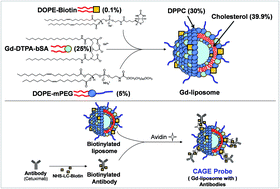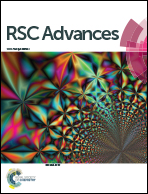Liposomal nanoprobes that combine anti-EGFR antibodies and MRI contrast agents: synthesis and in vitro characterization
Abstract
Targeted delivery of antibodies has emerged as an option for treating cancer. One antibody that is used clinically is the epidermal growth factor receptor (EGFR)-inhibiting monoclonal antibody, Cetuximab. EGFR is overexpressed on many tumor cell membranes, and the binding of antibodies to these receptors inhibits the proliferation and metastasis of the cancer. However, no diagnostic tools currently exist to monitor the in situ binding of antibodies to tumor cells in real time. To address this deficiency, we have created a liposomal probe bearing anti-EGFR antibodies and chelated gadolinium (Gd), a positive (image-brightening) contrast agent for magnetic resonance imaging (MRI). Our strategy to synthesize these probes has been carefully designed to be simple and scaleable: it employs two steps that each involve self-assembly. In the first step, biocompatible phospholipids, a chelated-Gd lipid, and a biotinylated lipid are used to form liposomes. In the ensuing step, biotinylated antibodies are attached to the liposomes using avidin as linker. The resulting probes preferentially bind in vitro to EGFR-overexpressing tumor cells compared to controls. Moreover, cancer cells with bound probes can be easily tracked using MRI. In the future, these probes could find clinical use for tracking the efficacy of cancer treatment in real-time by MRI.


 Please wait while we load your content...
Please wait while we load your content...